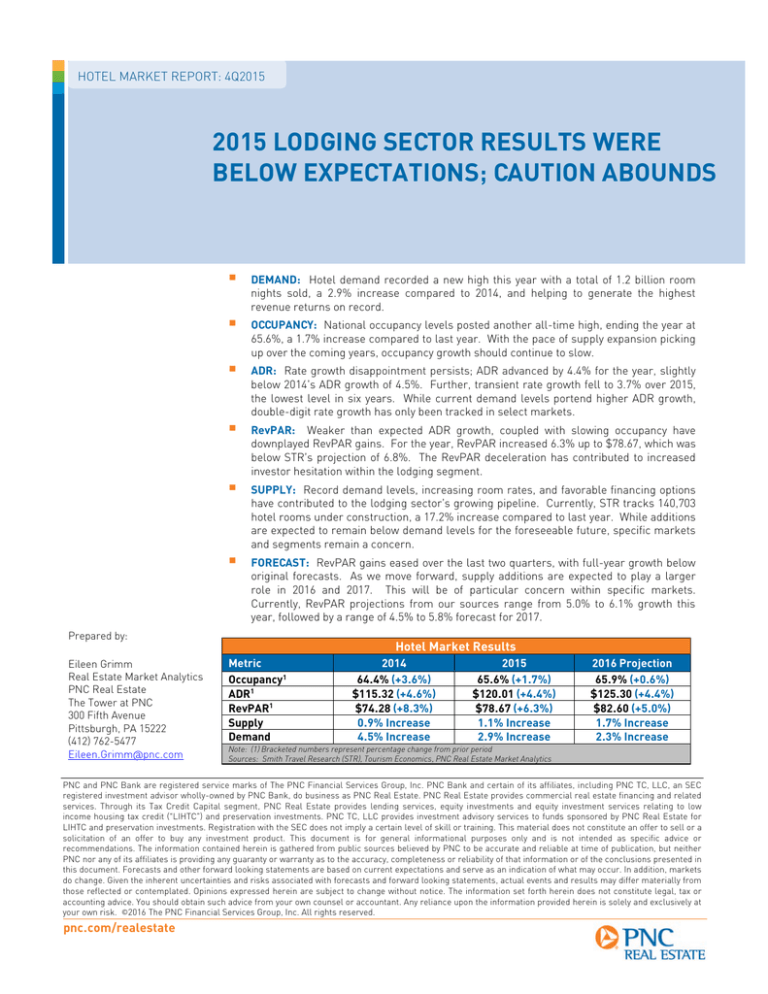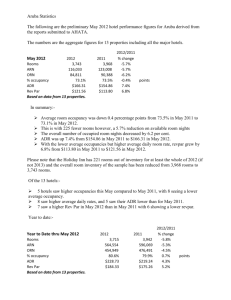
HOTEL MARKET REPORT: 4Q2015
2015 LODGING SECTOR RESULTS WERE
BELOW EXPECTATIONS; CAUTION ABOUNDS
DEMAND: Hotel demand recorded a new high this year with a total of 1.2 billion room
nights sold, a 2.9% increase compared to 2014, and helping to generate the highest
revenue returns on record.
OCCUPANCY: National occupancy levels posted another all-time high, ending the year at
65.6%, a 1.7% increase compared to last year. With the pace of supply expansion picking
up over the coming years, occupancy growth should continue to slow.
ADR: Rate growth disappointment persists; ADR advanced by 4.4% for the year, slightly
below 2014’s ADR growth of 4.5%. Further, transient rate growth fell to 3.7% over 2015,
the lowest level in six years. While current demand levels portend higher ADR growth,
double-digit rate growth has only been tracked in select markets.
RevPAR: Weaker than expected ADR growth, coupled with slowing occupancy have
downplayed RevPAR gains. For the year, RevPAR increased 6.3% up to $78.67, which was
below STR’s projection of 6.8%. The RevPAR deceleration has contributed to increased
investor hesitation within the lodging segment.
SUPPLY: Record demand levels, increasing room rates, and favorable financing options
have contributed to the lodging sector’s growing pipeline. Currently, STR tracks 140,703
hotel rooms under construction, a 17.2% increase compared to last year. While additions
are expected to remain below demand levels for the foreseeable future, specific markets
and segments remain a concern.
FORECAST: RevPAR gains eased over the last two quarters, with full-year growth below
original forecasts. As we move forward, supply additions are expected to play a larger
role in 2016 and 2017. This will be of particular concern within specific markets.
Currently, RevPAR projections from our sources range from 5.0% to 6.1% growth this
year, followed by a range of 4.5% to 5.8% forecast for 2017.
Prepared by:
Eileen Grimm
Real Estate Market Analytics
PNC Real Estate
The Tower at PNC
300 Fifth Avenue
Pittsburgh, PA 15222
(412) 762-5477
Eileen.Grimm@pnc.com
Hotel Market Results
Metric
Occupancy1
ADR1
RevPAR1
Supply
Demand
2014
64.4% (+3.6%)
$115.32 (+4.6%)
$74.28 (+8.3%)
0.9% Increase
4.5% Increase
2015
65.6% (+1.7%)
$120.01 (+4.4%)
$78.67 (+6.3%)
1.1% Increase
2.9% Increase
2016 Projection
65.9% (+0.6%)
$125.30 (+4.4%)
$82.60 (+5.0%)
1.7% Increase
2.3% Increase
Note: (1) Bracketed numbers represent percentage change from prior period
Sources: Smith Travel Research (STR), Tourism Economics, PNC Real Estate Market Analytics
PNC and PNC Bank are registered service marks of The PNC Financial Services Group, Inc. PNC Bank and certain of its affiliates, including PNC TC, LLC, an SEC
registered investment advisor wholly-owned by PNC Bank, do business as PNC Real Estate. PNC Real Estate provides commercial real estate financing and related
services. Through its Tax Credit Capital segment, PNC Real Estate provides lending services, equity investments and equity investment services relating to low
income housing tax credit (“LIHTC”) and preservation investments. PNC TC, LLC provides investment advisory services to funds sponsored by PNC Real Estate for
LIHTC and preservation investments. Registration with the SEC does not imply a certain level of skill or training. This material does not constitute an offer to sell or a
solicitation of an offer to buy any investment product. This document is for general informational purposes only and is not intended as specific advice or
recommendations. The information contained herein is gathered from public sources believed by PNC to be accurate and reliable at time of publication, but neither
PNC nor any of its affiliates is providing any guaranty or warranty as to the accuracy, completeness or reliability of that information or of the conclusions presented in
this document. Forecasts and other forward looking statements are based on current expectations and serve as an indication of what may occur. In addition, markets
do change. Given the inherent uncertainties and risks associated with forecasts and forward looking statements, actual events and results may differ materially from
those reflected or contemplated. Opinions expressed herein are subject to change without notice. The information set forth herein does not constitute legal, tax or
accounting advice. You should obtain such advice from your own counsel or accountant. Any reliance upon the information provided herein is solely and exclusively at
your own risk. ©2016 The PNC Financial Services Group, Inc. All rights reserved.
pnc.com/realestate
2015 Lodging Sector Results Were Below Expectations; Caution Abounds
2
LODGING SECTOR HIGHLIGHTS
Despite the record high room night
demand, rate growth was a
dissapointment in 2015.
While
hoteliers held out optimism for Q4,
travel growth was muted at the end
of the year. According to STR, room
rates moved up by 4.4% to $120.01
overall. Coupled with a 1.7% gain in
occupancy levels, RevPAR increased
6.3% - well below STR’s full-year
forecast of 6.8%. Moving forward,
RevPAR forecasts from our primary
sources (STR, PwC, and PKF) range
from 5.0% to 6.1% growth in 2016.
AIRBNB
AND
“DISRUPTIVE
SERVICES”
While the hotel industry’s initial
reactions to Airbnb and other
alternative accommodations were
mixed, recent reports and surveys
indicate that the services could have
a significant impact on traditional
hotels, particularly within gateway
markets. According to a January
2016 study from CBRE Hotels’
Americas Research, travelers spent
$2.4 billion on Airbnb lodging from
October 2014 to September 2015.
While the spending represents just
1.7% of the $141.0 billion generated
by the hotel industry, it is a
significant increase compared to the
same period one year ago. Further,
over the study period, more than 55%
of the $2.4 billion was within five U.S.
cities including NYC, Los Angeles,
San Francisco, Miami, and Boston.
Interestingly, the report also points
out that Airbnb rooms are not always
the lower-priced option. Over the 12
month period, the average rate paid
for an Airbnb unit was $148.42,
which is 25% higher than STR’s
average hotel ADR of $119.11
tracked over the same period. The
price disparity may be due to the higher-end amenties at Airbnb units, such as access to a kitchen, washing machine, and
free parking. Further, the majority of Airbnb listings tend to be within pricier downtown markets.
A February 2016 Goldman Sachs survey also points to an increasing consumer sentiment for “peer-to-peer” lodging like
Airbnb. The survey (2,000 respondents) indicated that if a consumer stayed at a sharing-economy accommodation during
the last five years, the liklihood that they prefer traditional hotels is halved (79% vs. 40%).
There is no shortage of coverage on the ongoing impacts from the non-hotel accommodations, which also includes
additional concerns such as taxes, safety, and zoning. However, as services like Airbnb continue to increase their market
share, traditional hotels must recognize the threat – especially as the industry braces for uncertain times ahead.
pnc.com/realestate
2015 Lodging Sector Results Were Below Expectations; Caution Abounds
3
SEGMENT PERFORMANCE METRICS
Source: Smith Travel Research
Demand – A total of 1.2 billion rooms nights were sold in 2015, a 2.9% increase compared to 2014. Although the pace of
demand growth is slowing, gains remain positive across all scales and locations. Among the chain scales, the Upscale
category was the winner with a 4.8% increase in rooms sold. However, this segment also saw the largest supply
expansion at 4.7%, with a significant number of new hotels still underway for 2016 and 2017 (see table below). Resort
hotels tracked an overall room night demand increase of 3.2%, the highest among the locational sub-classifications.
Suburban (+3.1%) and Urban (+3.0%) hotel locations were not far behind.
In February 2016, the U.S. Travel Association released its first Travel Trends Index (TTI), an indicator developed by the
organization’s economic research team to track and predict the volume and pace of travel to and within the U.S. The TTI
research indicates that travel growth leveled off at the end of the year, but is expected to pick up in early 2016. According
to the report, domestic leisure travel is increasing due to higher wages and lower gas prices. Business travel contracted
in late 2015, due to volatile markets and rising interest rates; however, a slight recovery is predicted for the first half of
2016. Finally, the report also noted that inbound international travel is still increasing slightly, but has leveled off due to
the strong U.S. dollar.
Occupancy – National hospitality occupancy levels reached 65.6%, an all-time high. However, growth continued to slow
with full-year 2015 occupancy up by just 1.7%; comparatively, occupancy gains over 2010 to 2014 averaged 3.4% annually.
For the year, all segments showed occupancy growth, with Independents again with the highest gain of 2.5%. Although the
upper tier scales (Luxury, Upper Upscale, and Upscale) report the highest occupancies, gains continue to slow with all
three segments well below 1.0% during 2015.
ADR – Forecasts for rate growth in 2015 were aggressive due to the record room night demand and occupancy levels;
however, ADR gains for the year were up 4.4%, well below STR’s forecast of 5.1%. Economy scale hotels proved the
highest returns, with rates increasing 5.0% YOY. Upscale hotels were a close second, up 4.9%. The lowest ADR growth
was among the Luxury and Upper Upscale segments, which tracked YOY growth of 4.2% and 4.0%, respectively. Among
the locational classifications, Airport hotels showed the highest ADR gain of 6.5%, well above the second place Suburban
hotels with an increase of 5.2%.
RevPAR – Over 2015, RevPAR increased 6.3% to $78.67, below full-year forecasts. Despite the lower
than expected results, 46 of STR’s Top 50 Markets displayed positive RevPAR growth in 2015. Top
performers included San Jose (+17.3%), Oakland (+15.7%), Portland (+14.2%), and Tampa (+13.8%).
Looking forward, RevPAR forecasts for the upcoming year are positive, with our hospitality sources
reporting a range of 5.0% to 6.1% growth in 2016. We also reviewed guidance from several public
hotel companies including Marriott International (MAR), Hilton Worldwide (HLT), Hyatt Hotels
Corporation (H), Starwood Hotels & Resorts Worldwide (HOT), Choice Hotels (CHH), FelCor Lodging
Trust (FCH), and Host Hotels & Resorts Inc. (HST). Please see adjacent table for details.
2016 RevPAR
Guidance
3.0%-5.0%
MAR
3.0%-5.0%
HLT
3.0%-5.0%
H
2.0%-4.0%
HOT
2.0%-3.0%
CHH
3.5%-5.5%
FCH
3.0%-4.0%
HST
Supply – According to STR’s December 2015 Pipeline Report, there are 3,881 hotel projects totaling 469,139 rooms under
contract within the U.S. The total activity represents a 13.6% increase year-over-year. Looking at only the hotels under
construction, the room count has reached 140,703, a 17.2% rise compared to one year ago. Among the chain scales, the
Economy segment tracked the most significant year-over-year increases in rooms under contract (+70.0%) and rooms
under construction (+130.8%).
U.S. Pipeline by Chain
Scale Segment
Luxury
Upper Upscale
Upscale
Upper Midscale
Midscale
Economy
Unaffiliated
Totals
Existing Supply
%∆ Dec14
Dec-15
108,485
+0.4%
583,906
+2.7%
660,640
+4.7%
888,843
+1.4%
479,040
-0.8%
784,149
+1.3%
1,533,422
-0.2%
5,038,485
+1.2%
In Construction
%∆ Dec14
Dec-15
7,440
+35.0%
11,524
-13.5%
49,203
+10.8%
47,954
+36.1%
5,321
+1.3%
1,512
+130.8%
17,749
+13.2%
140,703
+17.2%
Note: Under Contract pipeline includes in construction, final planning, and planning stages.
Sources: Smith Travel, CBRE-EA Pipeline, PNC Real Estate Market Analytics
pnc.com/realestate
Under Contract
%∆ Dec14
Dec-15
11,549
+18.7%
38,885
+23.4%
135,580
+18.1%
157,034
+23.9%
29,533
+17.0%
6,801
+70.0%
89,757
-11.0%
469,139
+13.6%
2015 Lodging Sector Results Were Below Expectations; Caution Abounds
4
Projections – Hotel projections provided by STR, PKF, and PwC indicate positive expectations over the coming two
years. Currently, RevPAR growth forecasts range from 5.0% to 6.1% for 2016. U.S. demand growth has outpaced
supply growth since 2010 and the forecasts indicate that this trend will continue over the coming years. According
to PwC’s updated lodging outlook (released January 25, 2016), demand trends across the U.S. are expected to
remain strong during 2016, driven by continued economic growth and improving group demand. The pace of supply
growth is forecast to increase to 1.9%, which is equivalent to the long-run average. As a result, PwC’s 2016 outlook
anticipates a marginal increase in occupancy levels to 65.7% - the highest level since 1981.
Hotel Market
Projections
Occupancy
ADR
RevPAR
Supply
Demand
STR
2016
2017
65.9% (+0.6%)
66.1% (+0.2%)
$125.30 (+4.4%)
$130.63 (+4.3%)
$82.60 (+5.0%)
$86.28 (+4.5%)
+1.7%
+1.9%
+2.3%
+2.1%
PKF-HR
2016
2017
66.0% (+0.6%)
66.0% (0.0%)
$126.93 (+5.5%)
$134.28 (+5.8%)
$83.81 (+6.1%)
$88.68 (+5.8%)
+1.7%
+2.1%
+2.3%
+2.2%
PwC
2016
65.7% (+0.2%)
$126.28 (+5.2%)
$82.96 (+5.5%)
+1.9%
+2.1%
2017
-
Sources: STR, Tourism Economics, PKF-HR, PwC Hospitality Directions U.S., PNC Real Estate Market Analytics
MARKET PERFORMANCE METRICS
Construction
For the overall U.S. hotel industry, STR is forecasting supply
expansion of 1.7% during 2016, still below the long-term average of
2.0%. However, the most significant risks are where the majority of
new supply is located. As of December 2015, the top markets for
construction included NYC, Houston, Los Angeles, Dallas, and
Miami, all with over 3,500 rooms underway. In total, these five
markets account for nearly one quarter of all rooms under
construction within the U.S.
As has been the case for several years, NYC maintains the top spot
in terms of number of rooms under construction. New rooms
underway currently represent 12.0% of the metro’s existing supply.
Further, Manhattan’s hotel performance has been lackluster with
decreases tracked for both occupancy and ADR over 2015, equating
to RevPAR loss of -1.7%. It is likely that supply side pressures have
been amplified by units available through Airbnb; though increasing
scrutiny from the New York Attorney General may have an impact
on Airbnb’s ability to keep growing in the future.
Construction in Top 26 Markets:
12 with 4%+ of supply
Rooms
% of
Market
U/C
Existing
New York City
14,090
12.0%
Miami
3,920
7.6%
Houston
5,710
7.1%
Seattle
2,232
5.3%
Dallas
4,177
5.3%
Philadelphia
2,343
5.1%
Nashville
1,982
5.1%
Boston
2,627
5.1%
Minneapolis/St. Paul
1,949
5.0%
Los Angeles
4,240
4.3%
Anaheim/Santa Ana
2,328
4.2%
Denver
1,794
4.1%
Note: U.S. Pipeline, Top 26 Markets, U/C Rooms as a
% of Existing Supply, December 2015. Source: STR
We continue to monitor Houston. In terms of construction, the metro is ranked second with over 5,710 rooms
underway. Over 2015, occupancy in the metro declined by -4.8%. Rates held steady, tracking a minimal +1.6%
increase; however, overall RevPAR moved downward by -3.3%, which was the largest decline among STR’s Top 50
Markets.
As noted in prior reports, Houston’s room night demand relies heavily on business from the energy
sector and the additional supply could further strain fundamentals.
pnc.com/realestate
2015 Lodging Sector Results Were Below Expectations; Caution Abounds
5
Top 50 Market Performance
The chart below plots performance metrics for the 50 largest hotel markets in the country. The YTD change in
occupancy from 2014 to 2015 is depicted along the horizontal axis and the change in ADR is along the vertical axis.
While most metros have tracked positive ADR growth, occupancy gains have clearly slowed, with a handful of
markets reporting negative returns. Over 2015, nine of the 50 markets posted negative occupancy trends. Supply
expansion has certainly played a role in the losses; the average room availability increase among the laggers was
3.0%, compared to the Top 50 average of 1.2%.
During 2015, Bay Area metros led the Top 50 for both ADR and occupancy growth. In terms of ADR growth, San
Jose and Oakland were stand-outs, with increases of 14.6% and 12.0%, respectively. These were the only two
markets among the Top 50 with double-digit rate growth. Sacramento was also a top performer for occupancy
growth, with levels rising by 6.8%. A key factor to the success of these markets has been tempered supply
expansion - room night supply among the three markets expanded by an average of just 0.3% over 2015.
pnc.com/realestate
2015 Lodging Sector Results Were Below Expectations; Caution Abounds
SALES VOLUME AND CAPITALIZATION RATES
2015Q4 Review
According to Real Capital Analytics (RCA), hotel investment
totaled $49.4 billion in 2015 – the highest annual volume
since 2007. The activity was driven by portfolio and entitylevel deal volume, which totaled $20.5 billion in sales, up
59% annually. However, deal volume was choppy over the
course of the year, with the third quarter showing a 21.0%
YOY decline in sales volume due to investor unease. The
fourth quarter of 2015 posted a sharp turnaround, with
volume growth of 47.0% YOY.
Year
2012
2013
2014
2015
Hotel Transaction Summary ($B)
Individual Portfolio
Entity
$13.8
$3.9
$3.0
$17.6
$8.4
$1.3
$21.9
$9.9
$3.0
$28.9
$12.3
$8.2
6
Total
$20.7
$27.3
$34.8
$49.4
Note: Data based on properties and portfolios $2.5M and greater.
Source: Real Capital Analytics
Based on initial estimates for Moody’s/RCA CPPI hotel index, prices have appreciated 16.0% year-over-year, which is
close to the 16.5% rate set in 2014. Blackstone’s buyout of Strategic Hotels accounted for $6.0B (approximately
$754,000 per key) of total volume during Q4. The 17-hotel portfolio included the Pennsylvania Avenue Four Seasons
in Washington DC, the Union Square Westin in San Francisco, and the beach-front Ritz Carlton in Orange County,
CA. Another significant transaction posted during the final quarter of 2015 was Maefield Development’s acquisition
of the leasehold interest in the Times Square Doubletree from Sunstone Hotel Investors for $540 million
(approximately $1.2 million per key).
Overall hotel cap rates have been flat since 2012, averaging 8.2% over the past three years according to RCA.
However, trends are evident depending on subtype and location. Looking at full-service asset types within the core
major markets, cap rates bottomed out at 6.2% in February 2015, increasing each month since then and hitting 7.1%
as of December. However, full-service assets in secondary markets have been flat at about 7.8% since mid-year
2014. The one area that compression has been tracked by RCA is within the tertiary markets. Cap rates within
these markets were 8.2% in early 2014, but declined to 7.8% as of December 2015.
pnc.com/realestate


